Lunar Landscapes, Slave Labor, and Narrative Manipulation: the Northwest and Hanoi
- Aaron Schorr
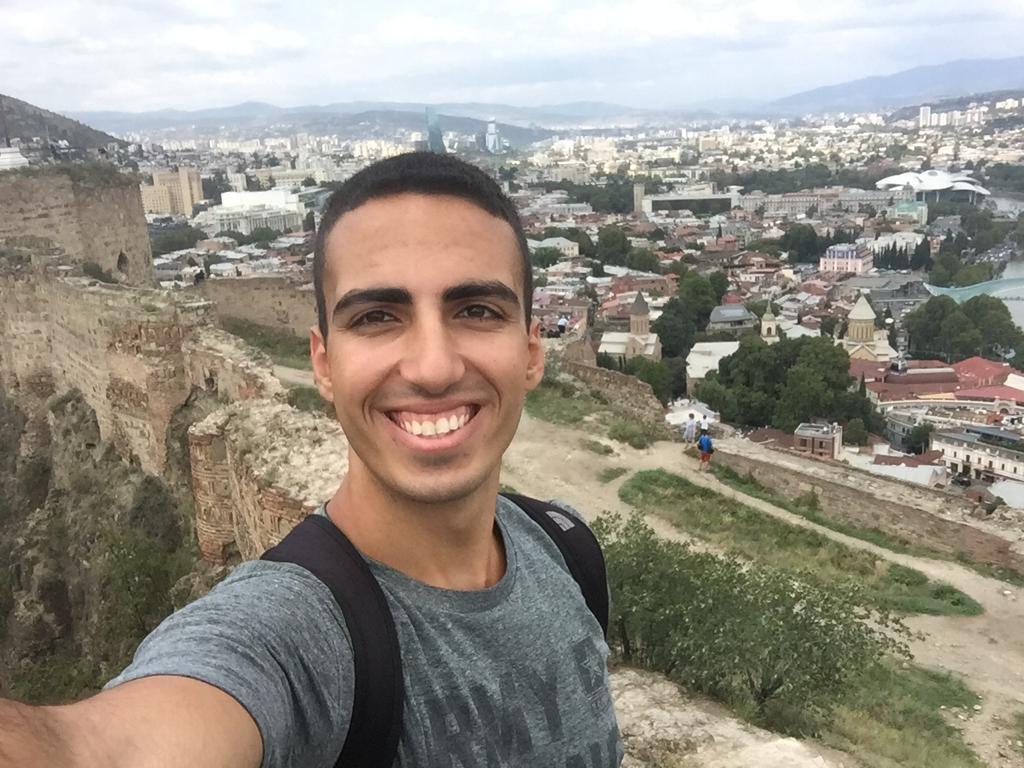
- Feb 20, 2020
- 12 min read
The QL4C out of Mèo Vạc is part of what's known as the Hà Giang Loop, a scenic route named after the province most of it is in. The Loop has achieved near-mythical status among travelers to Vietnam and has become a rite of passage for those who want to say they "rode" Vietnam. Most people ride from Hà Giang to Bảo Lạc on the QL4C and then back on another, less scenic road to close the loop. I had decided to do only one leg of the Loop in the "wrong" direction, since the scenery in the north-east looked too good to miss and since I didn't have to return my bike in Hà Giang like most people did. Technically, I had been on the Loop since arriving in Bảo Lạc the previous afternoon, but not many of the tourists go the way I did (read the previous post if you haven't yet to understand why).
Less-Than-Formal Border Guards
I was sure I had lost the keys to my bike the next morning and spent an embarrassing amount of time searching for them, only to have A Sấn's daughter find them in the seat lock. Immediately to the north of Mèo Vạc is the Mã Pí Lèng Pass, the stretch of road I had most been looking forward to in Vietnam, and it did not disappoint. The pass looks like it belongs in a much higher mountain range and definitely not in Southeast Asia, with tight curves hugging the mountainside and dramatic views of the steep Nho Quế River gorge below. The morning mist shrouded the mountains and made it feel even higher and colder.

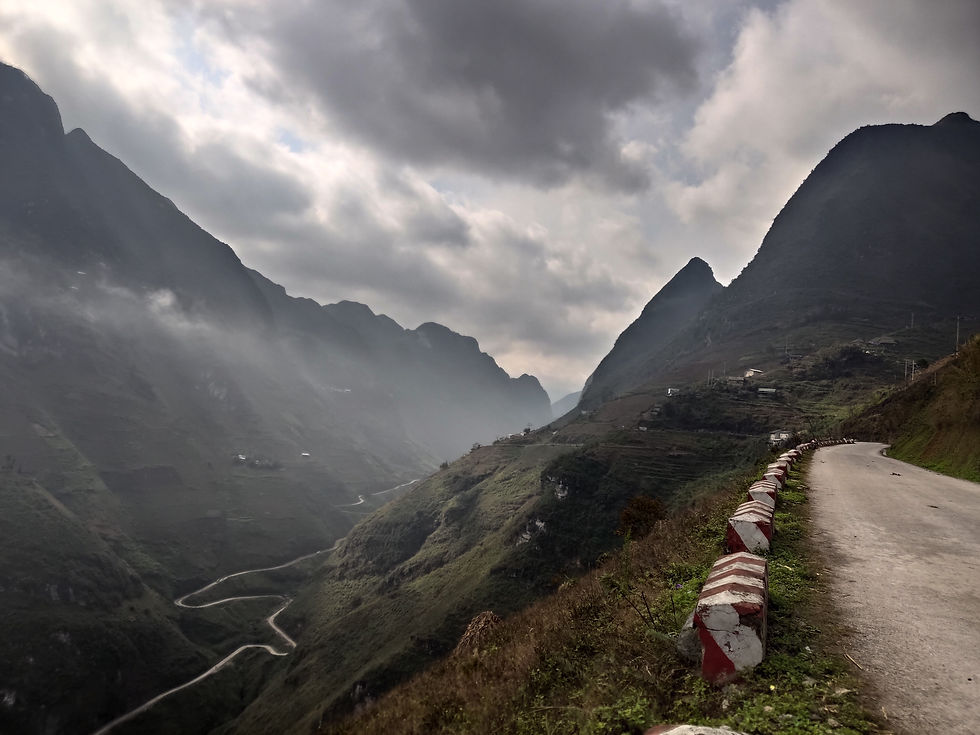
At the top of the pass, I found a monument elaborately carved with scenes of road-building. The monument was dedicated to the minority slave-children who had toiled for years in subhuman conditions to build the "Happiness Road" into the far north, during which time 14 of them died-- erm, sorry, it was dedicated to the "youth volunteer forces who proudly conquered nature, opening the road to happiness" and will "surely stir in the hearts of visitors the pride and gratitude to the previous generations", as the plaque reads. Excuse me, I had a bit of imperialist reactionary stuck to my keyboard.
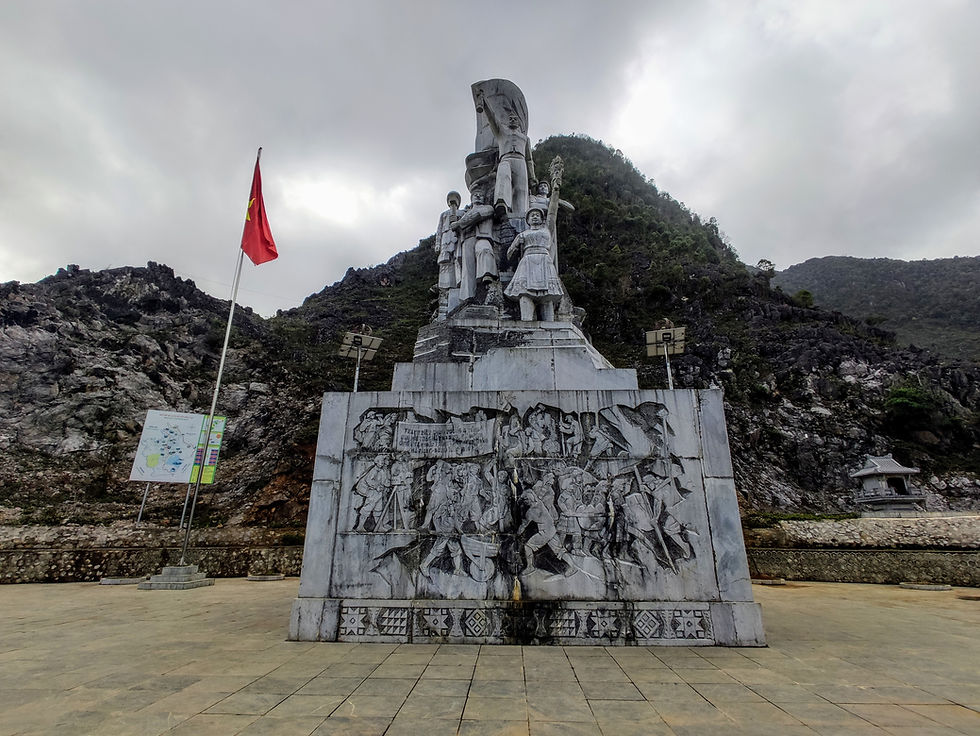
After the pass, I turned north off the QL4C onto a horribly bumpy provincial road that drew very close to the Chinese border, until it was just at the top of some low hills to my right. I stopped at the nearest point and found a narrow track heading up the hill. It was only about 15 meters to what Google said was the border, and sure enough there were barbed wire fences blocking the way in two places where the forest wasn't thick enough to deter people from crossing, the closer fence seemingly in Vietnam and the further one in China.
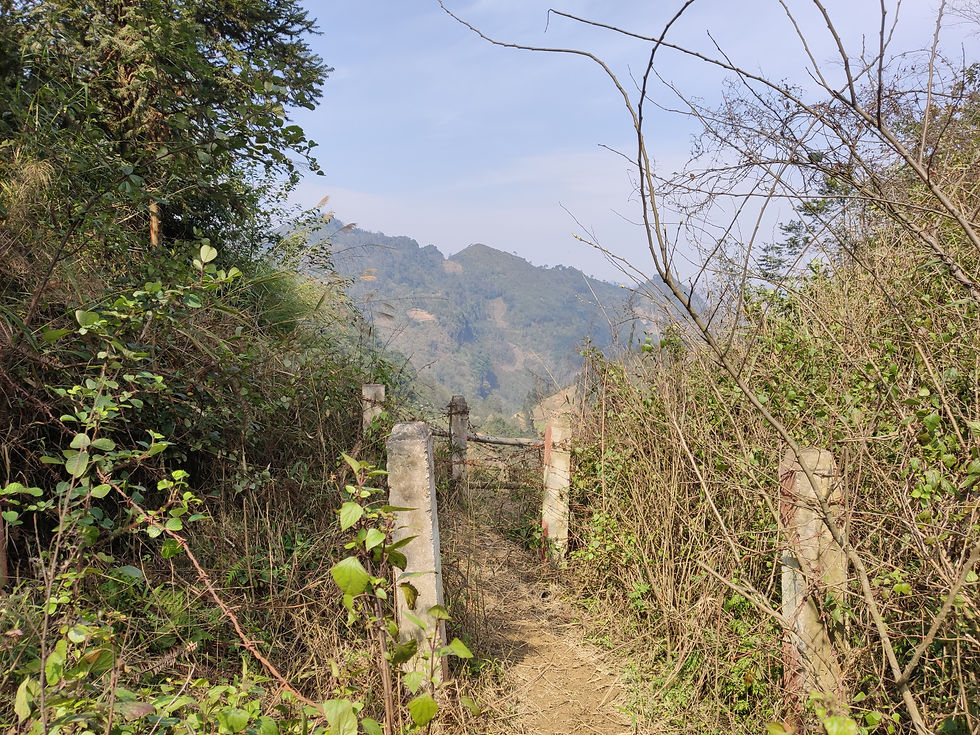
I was minding my own business, taking some photos of the fences, when a guy wearing camouflage and flip-flops yelled at me from the back of a scooter on the road. Unsure if he was a civilian or not (in rural areas in Vietnam it's totally normal for civilians to wear full camo), I thought he was telling me not to get close, but he kept yelling and gesticulating excitedly. I gave him a thumbs-up and walked back towards the road, he said "China!" a few times and then some other things I couldn't pick up and made sure I got on my bike and rode off. 100 meters down the road, there was another path leading to the border with a big sign I couldn't read from the road; I tried going there but Mr Flip-Flops had set up camp with some other guards and prevented me from getting further than the edge of the road.
Vietnam's North Pole
Many potholes later, I made it to the town of Lũng Cú, which had evidently been included in the list of places to get a new boulevard, with construction crews hard at work paving it. Surrounded by China on three sides, Lũng Cú is the northernmost settlement in Vietnam. Never ones to miss out on exhibiting their patriotism, the Vietnamese government has erected a massive tower, known among travelers as "the North Pole", on the top of a hill overlooking China, topped with a 54 m² flag representing the 54 ethnic groups that make up Vietnam. It was worth the 300 steps climb, with views of the Nho Quế River and seemingly untouched nature on the Chinese side, and the climb was made easier by patriotic music playing out of speakers by the stairs. I Shazamed the tune so you too can step back into the Cold War with the lovely lyrics:
Long distance future home
is inviting today's youth to join hands to build a new day.
Whether in the woods or into the sea,
young people firmly step shoulder to shoulder, my friend.
Do not ask what the Fatherland did for us,
but need to ask what we have done for our country today.
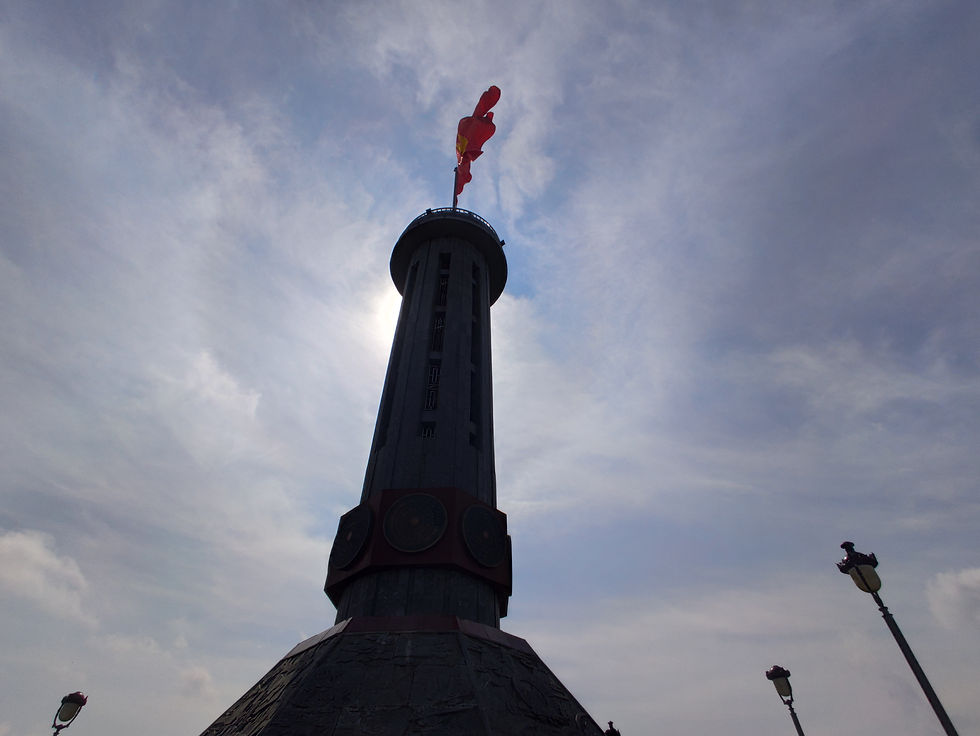
The Loop is positively infested with Israelis and nowhere was it more obvious than here, where group after group of Israelis stop to take a picture waving a Vietnamese flag at the top of the tower, providing the Communist Party with an unlikely propaganda victory. Strangely, the Israelis also avoid riding nearly to a man, preferring to do the Loop as pillion passengers with local rider-guides. Honestly I wish more tourists were like them, since much of the Loop is clogged with annoying backpackers who think the extreme mountain roads are the perfect place to learn how to ride a motorcycle, with predictable results. The accidents must have gotten out of control, because most of the road actually has safety railings and - amazingly! - parabolic mirrors before blind turns, which goes to show you what an impact tourism money can have on a rural area.
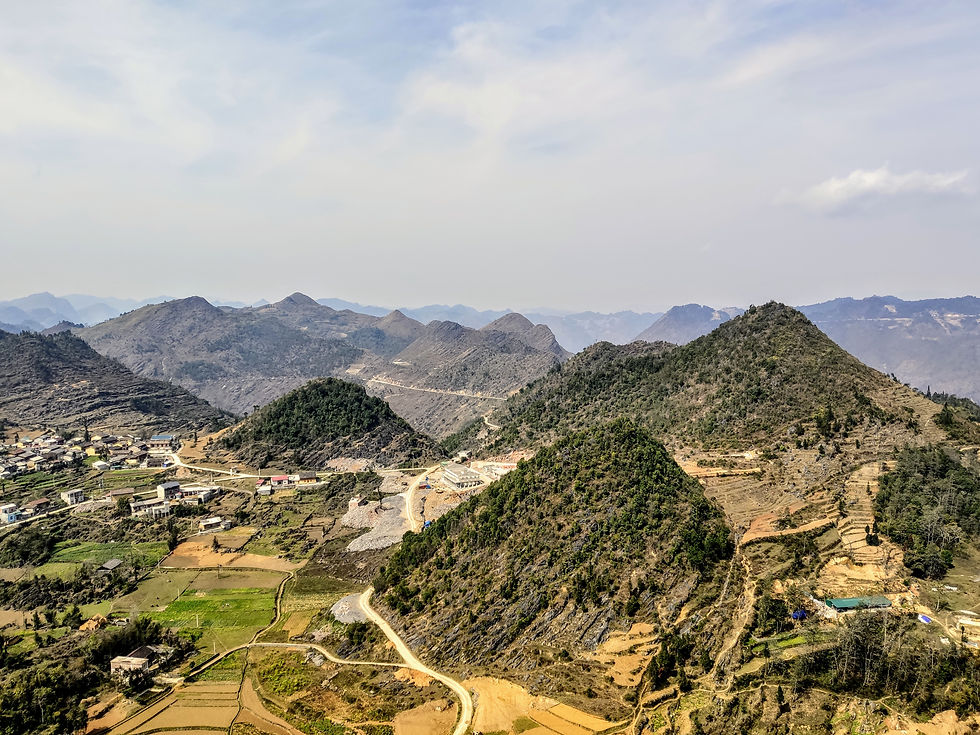
Flower Girls and Suspicious Leaves
I left the North Pole and rode onto the Đồng Văn Karst Plateau. The landscape changed dramatically yet again, and I found myself surrounded by barren hills covered in sharp rocky formations, giving the place a distinctly lunar feel. It felt alien and inhospitable, a far cry from the rice terraces and lush vegetation which had been the norm in the far north.
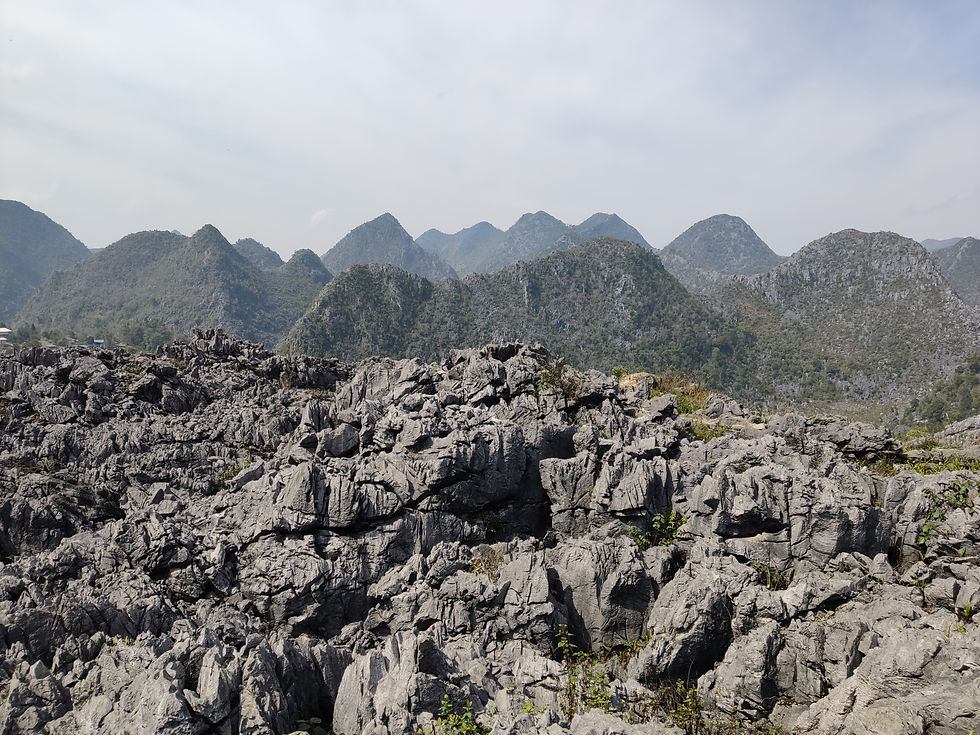
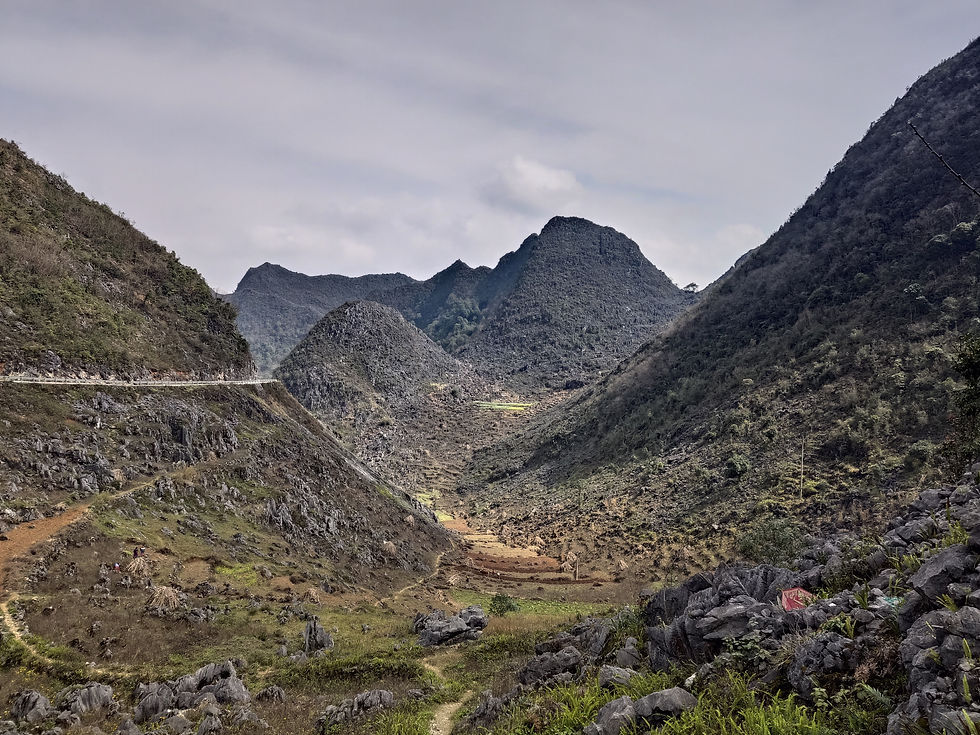
The village of Sủng Là was deep in H'mong country and had a traditional tribal house to visit. Walking around the village were little girls in colorful dresses carrying fresh flowers in baskets on their backs made me understand how the indigenous tribes had been living in isolation for so long, despite being sandwiched between two rather militant and powerful empires for the past millennium.
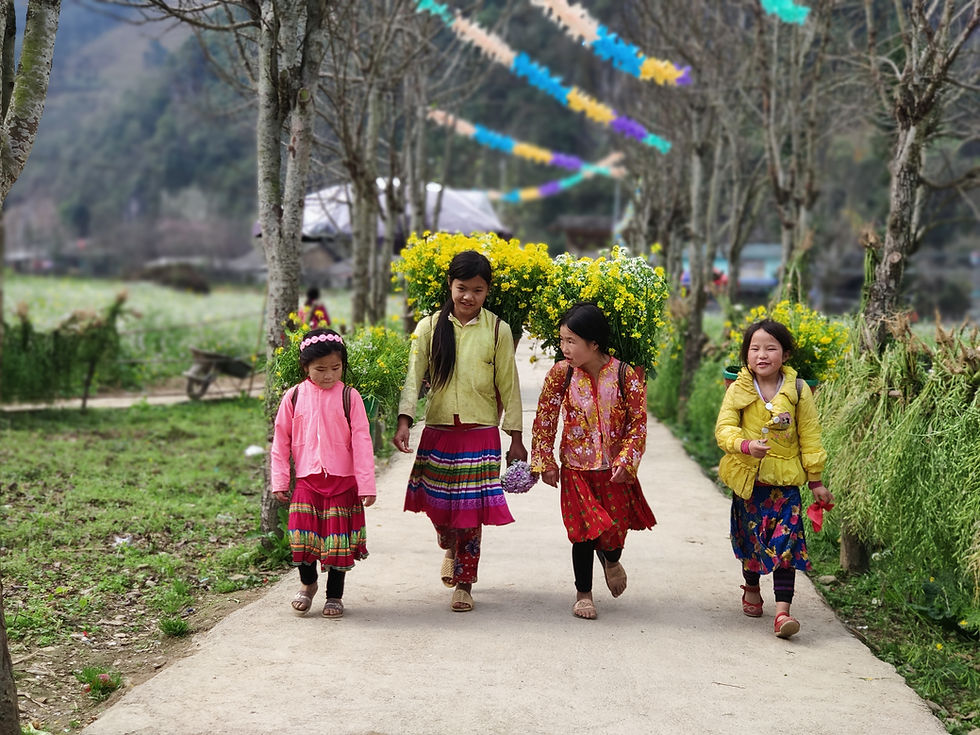
The next big town was Yên Minh, where I chose a homestay and discovered I was the first and only guest to arrive. Fortunately, three guys - two Canadians and a Brit - on dirt bikes showed up soon after me and we went out to "the strip", as they called the main road in search of some post-ride beer. We sat down in a bar advertising screenings of "foolball" next to some locals, who immediately started toasting us and handed us four small packages. While initially suspicious, the packages turned out to contain a sort of garlicky salami tightly wrapped in banana leaves, not particularly delicious but still a pleasant surprise. They asked me how old I was and were shocked at the answer, demanding to see my ID to prove I was so young. I was equally surprised at their ID's; they were a full decade older than I expected.
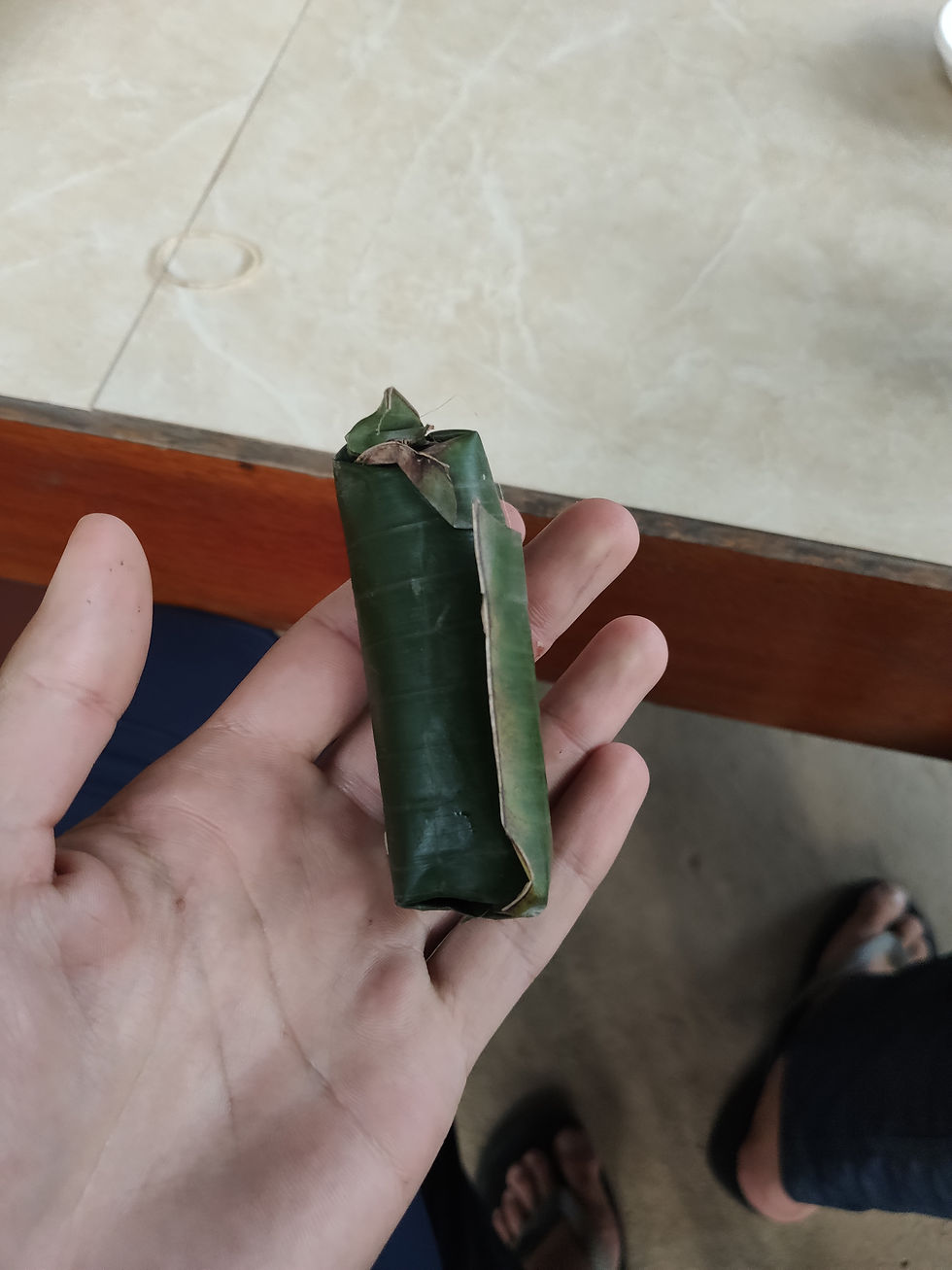
We all swapped war stories from our riding adventures. It turned out the Brit, whose name was Fraser, had actually had a biking adventure, riding from Saigon to Hà Giang in six weeks, resting every fifth day. I was impressed, especially seeing as he wasn't German or Dutch, the first biker I had met from any country but those two. He wasn't even the most unlikely person I met in Yên Minh; that title belongs to Abuka, a Mongolian living in Austria who spoke perfect American English and warned me off my planned visit to his homeland in March, saying it was too cold. A Mongolian telling you something is too cold is a serious warning, especially one who had just told me about a camping trip he had done on the shores of Lake Baikal in -20°C weather.
From Poor Villages to the Capital
The next day was my final day in the mountains and the shortest ride, an easy 99 kilometers to the provincial capital of Hà Giang. The first half of the road was under construction, making for very bouncy progress until I reached the Lô River valley, which brought the best mountain road I had seen yet. With the green alpine valley views, I could have been in France, until an attempted detour brought me back to reality. I turned onto the DT181 road, which must have been a nice road once but today felt like a land mine had been set off every five feet, with a surface so muddy and rocky I turned back after barely a kilometer.
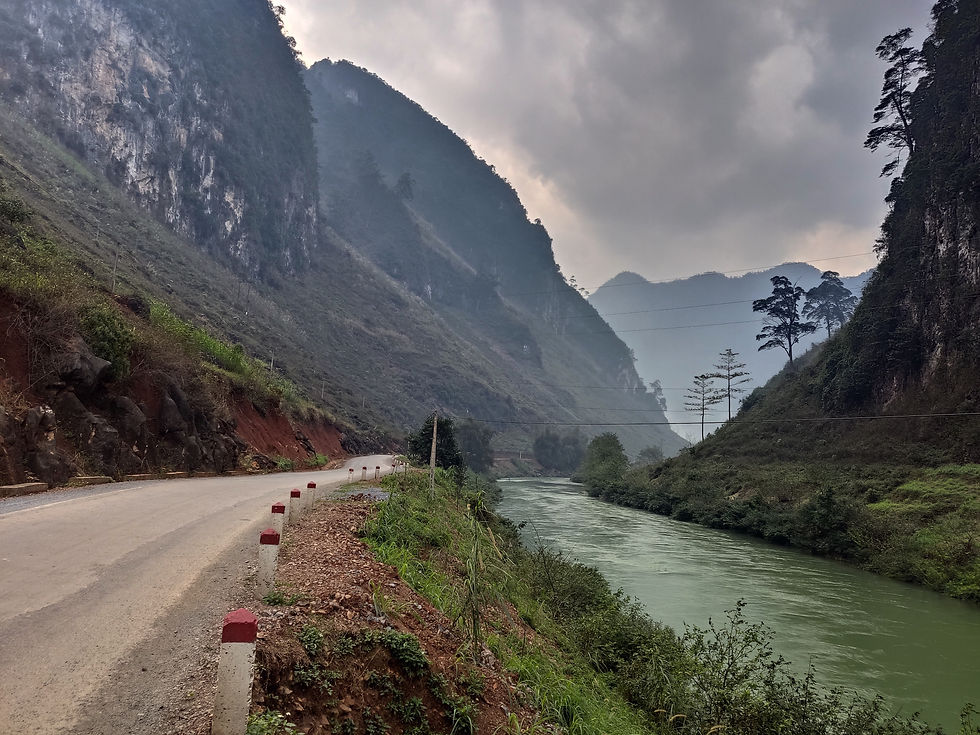
There seemed to be a shortcut back to the highway through a small village, which turned out to have made the bone-jarring experience worth it. The dirt-poor minority village was evidently not accustomed to strange foreigners riding through it, with plenty of suspicious stares as I bought a weird Cheetos-like snack from a roadside stand and had a look around the owner's house, which had a wall full of official certificates and a large portrait of Ho Chi Minh front and center.
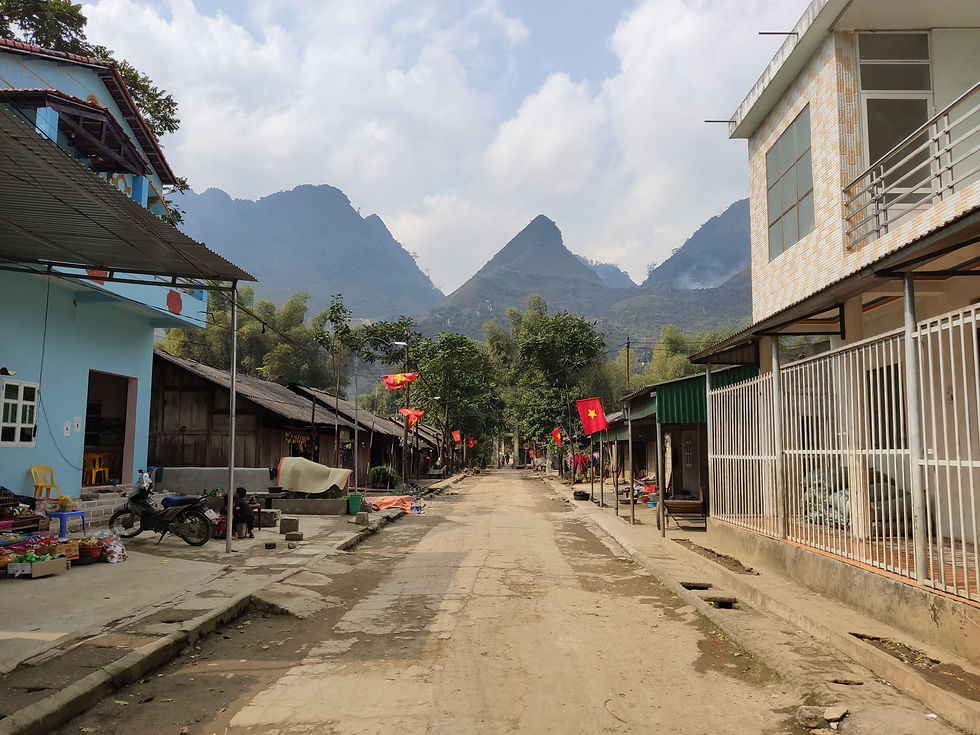
In my experience, the mountain tribes were much less friendly than other Vietnamese, which wasn't really surprising when I considered their history. They had been living in near-complete isolation for generations, until first the Vietnamese showed up, with their slave-labor roads "bringing along 'electricity-school-health care'”, as per the Happiness Road monument, and then the adventure tourists arrived in ever-growing numbers.
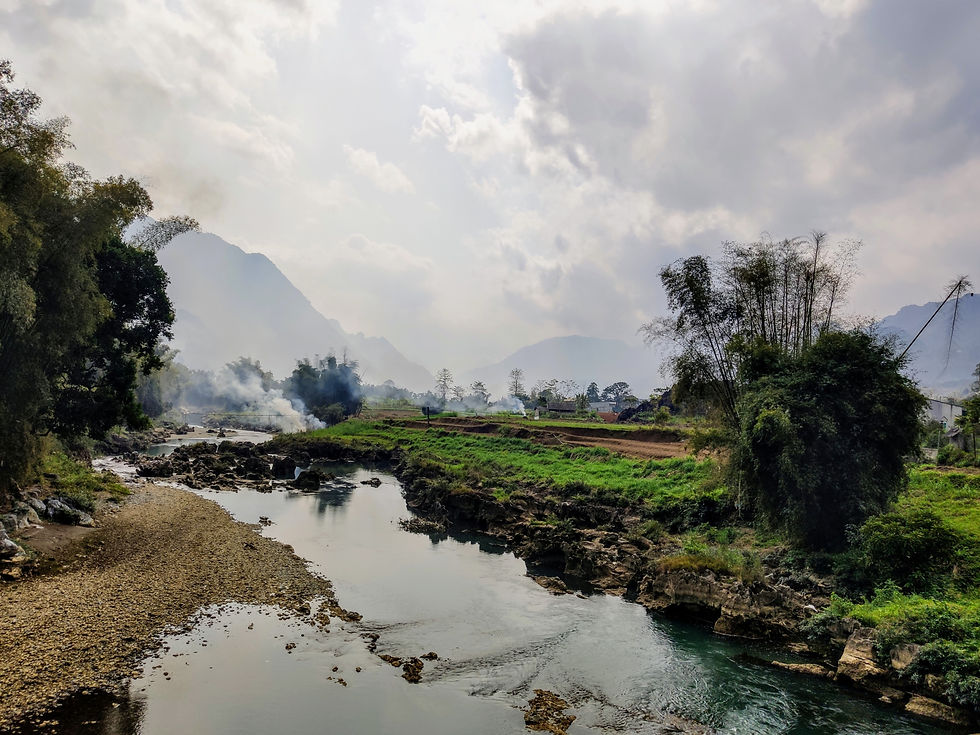
After passing several roadside bars and restaurants, living examples of the effects the visitors have had on the area, I made another detour on a narrow concrete path that led to the village of Bắc Sum, high above an unnamed river gorge. It was surprisingly hot that day and the air had become seriously hazy by then, obscuring the view again. It seemed the pendulum had made a full swing, and in only 48 hours the weather had changed from cold, wet, and foggy to hot, wet, and hazy, but at least I had had a period of fantastic conditions in between, which is more than a lot of visitors to this area can say, notorious for rapidly-changing and extreme weather. Other travelers had told me stories of consecutive days of thick fog, so I was grateful for what I had got.
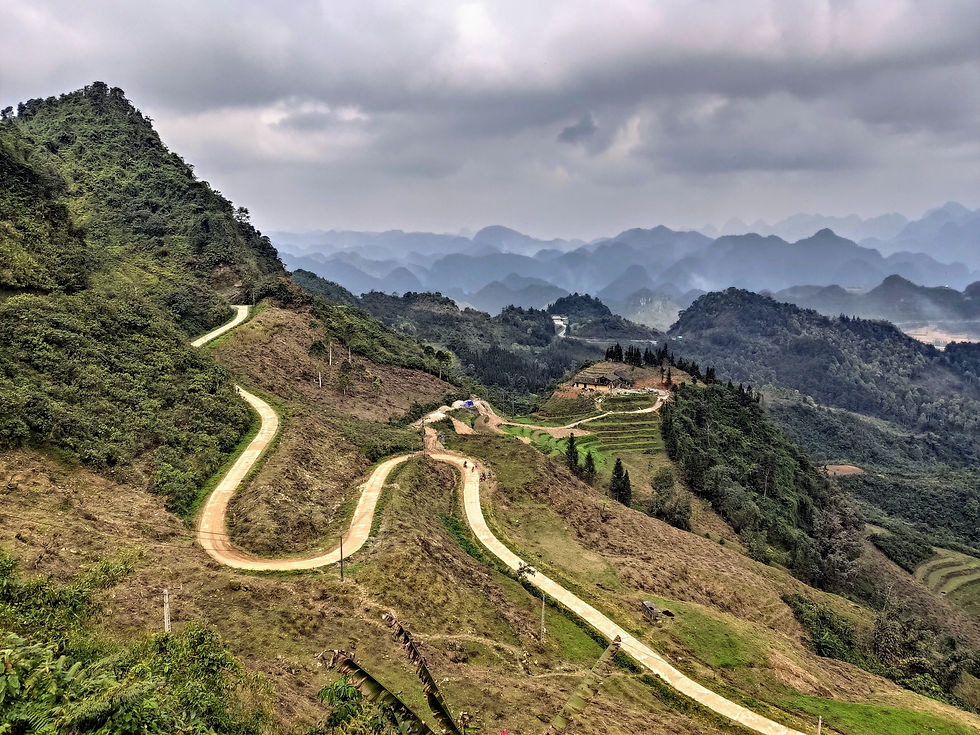
After playing a game of chicken with a police car on the highway, I arrived in Hà Giang to another empty hostel. I still had a lot of daylight left, so I set off along the other leg of the Loop with the goal of making it to a nice viewpoint and turning back, but the riding was terrible and I had had enough of that for the time being. It was kilometer after kilometer of construction sites, with obnoxious minibuses everywhere and choking dust in the air made worse by both. I turned around towards Hà Giang and eventually found my way to a pleasant waterfall, where I savored my last moments in the mountains.

My room was neither dark nor quiet, so I was up before 7 the next morning for my last proper ride. I made fast progress down the Lô River Valley, leaving the mountain roads for dusty highways in Tuyên Quang Province, which gradually became highways as I drew closer to Hanoi. I entered the city on the gargantuan Nhật Tân Bridge, crossing the Red River on yet another piece of Japanese infrastructure and diving into the Hanoi traffic, which wasn't as bad as Saigon but still a challenge after so much time in the countryside.
I had the afternoon to myself and visited the Military History Museum, where besides lots of weapons and a statue built out of B-52 wreckages on display there was even more historical narrative manipulation. The epic defeat of the French Army at Dien Bien Phu in 1954 was highlighted as "one of the greatest military events of the 20th century", the Chinese weren't mentioned by name in the "border disputes" of the 1970s, and the North Vietnamese Army and people casually waltzed to victory in their liberation war against the US.
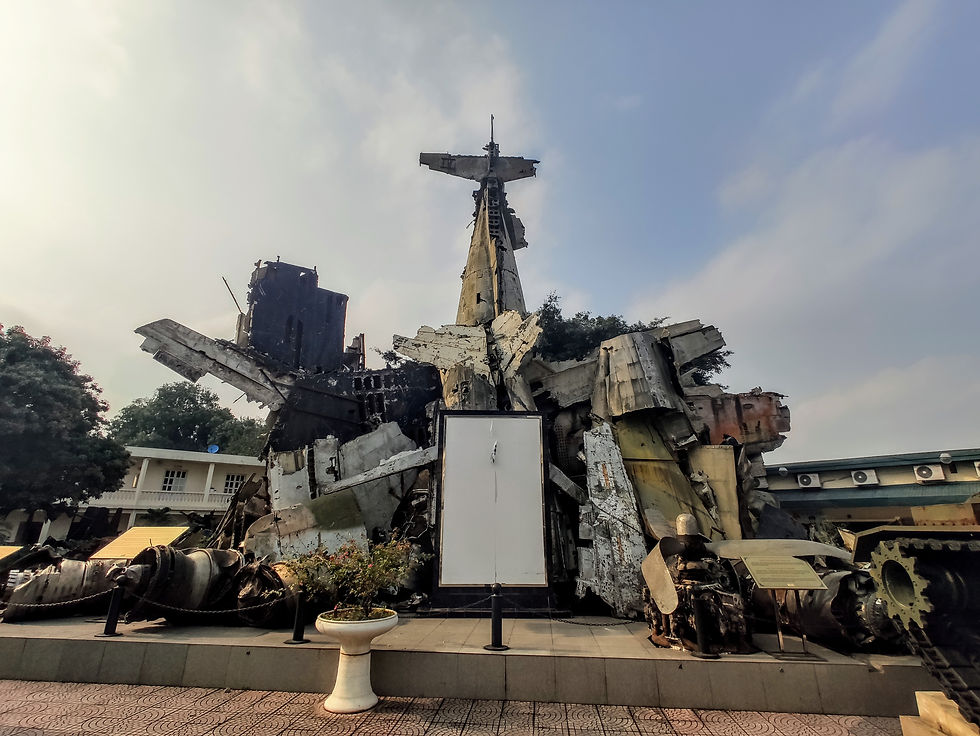
Even the Communist-nationalist bravado reached an all-time peak, with such statements as "under the leadership of the [Communist] Party, our people go from victory to victory, making [...] great contribution to the international Communist movement and workers, for the peace and progress of mankind." Big words from a regime which has essentially abandoned Communism in all but the aesthetic; Marxism-Leninism essentially only remains as a vestment for the continuation of the one-party system in the mostly free-market, autocratic Vietnam of the 21st century.
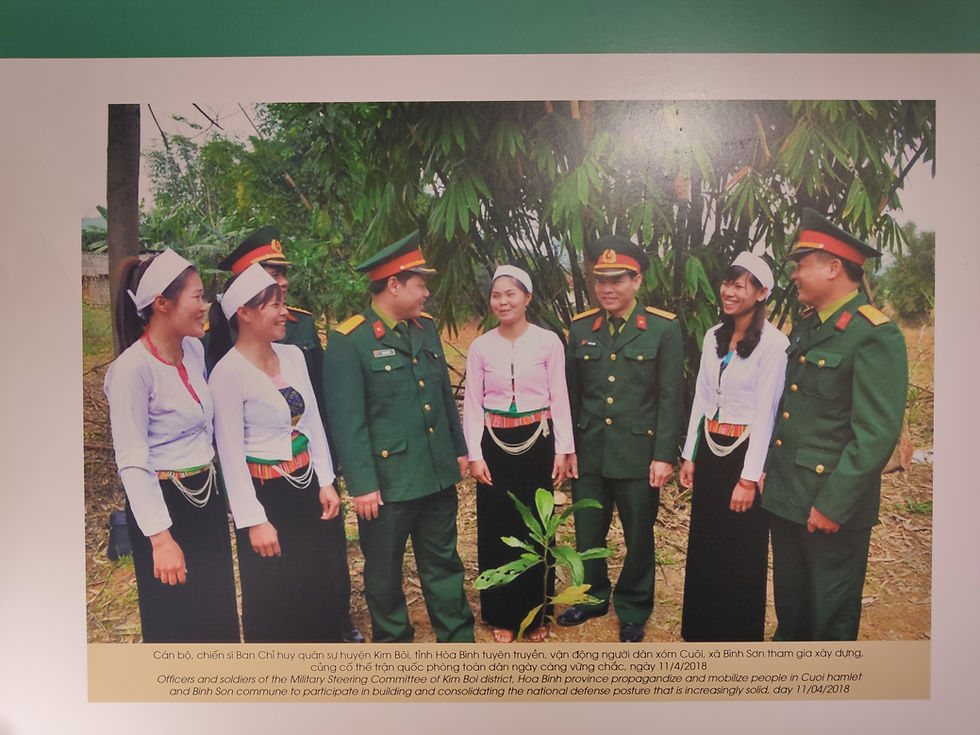
Yotam, one of my best friends from the military, was landing the next morning, so I rode back to the airport to pick him up, shivering in the morning chill after the temperature had dropped 12° overnight again. He needed coffee, so what better opportunity to try cà phê trứng, or egg coffee, a local Hanoi specialty? Egg coffee is made by whipping a fresh egg yolk with sugar and pouring it on top of strong drip coffee, making for a strange contrast between bitter and sweet, hot and cold, delicious coffee and a salmonella risk.
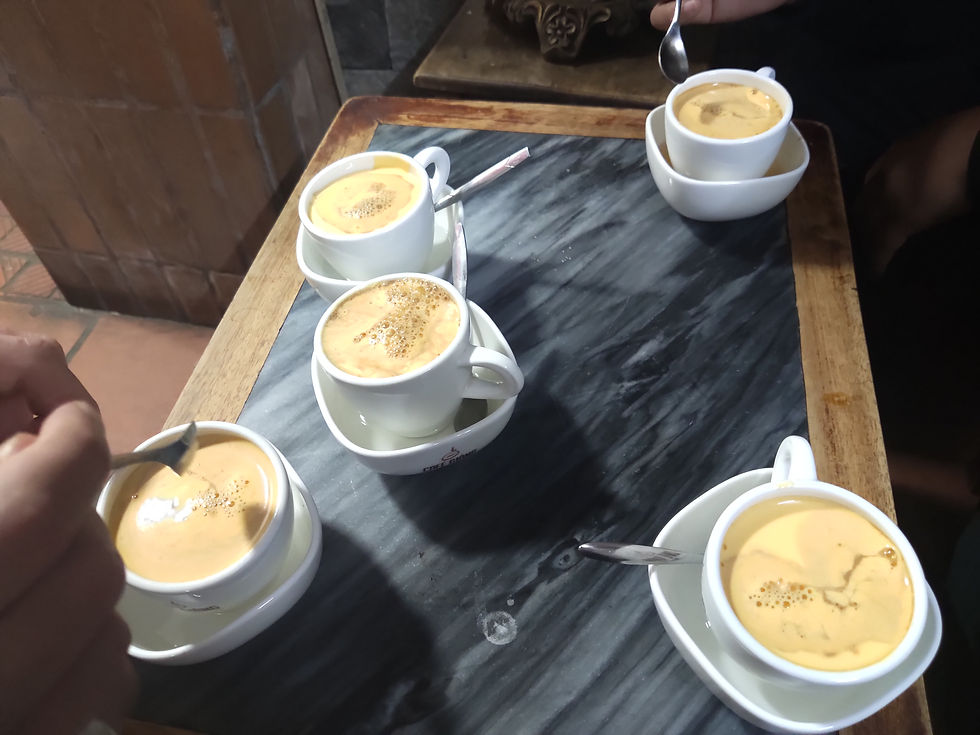
Yotam got settled in and we paid a visit to the Hỏa Lò Prison, better known as the Hanoi Hilton, where many downed US airmen were imprisoned during the war, for more historical manipulation - did you know the North Vietnamese treated American POWs with silk gloves? Vietnam's main north-south rail line cuts through the center of Hanoi, running at street level for a few hundred meters either side of the train station, with houses and cafés only feet away from the tracks. These "Train Streets" have become strange tourist attractions, to the point that the government has officially banned access to them for safety reasons. This being Vietnam where money speaks louder than words, the actual reality is that there are security guards at every entrance who refuse to let you in unless you get a café owner to bring you in. Watching a passenger train thunder past only inches from your seat, puffing thick smoke and blaring its horn, is a strange experience and I can't imagine it'll continue much longer.
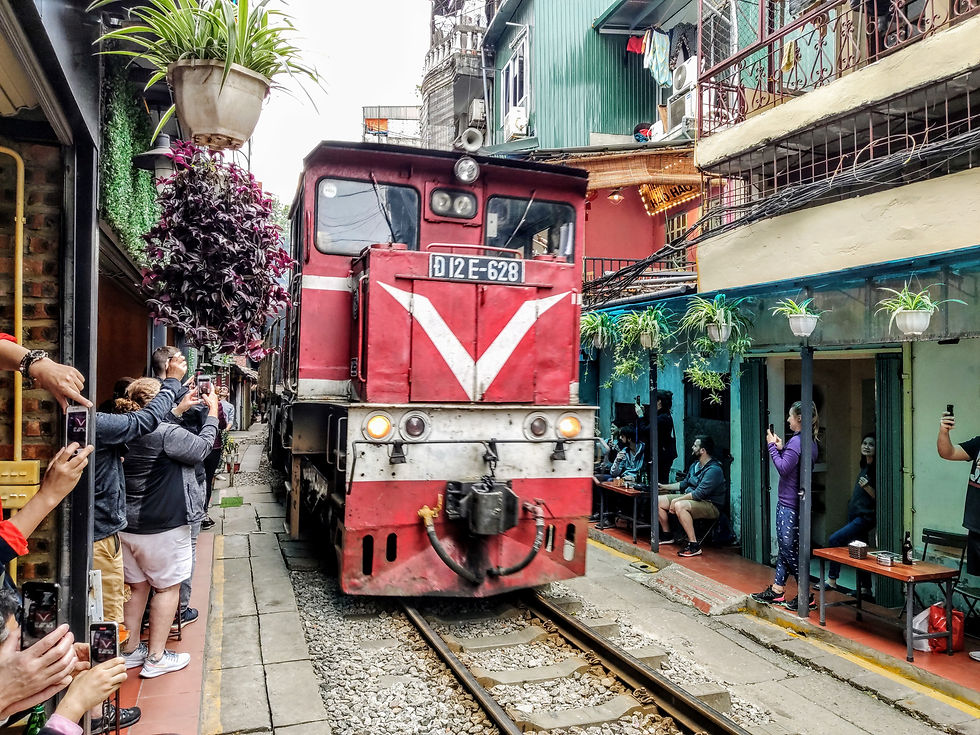
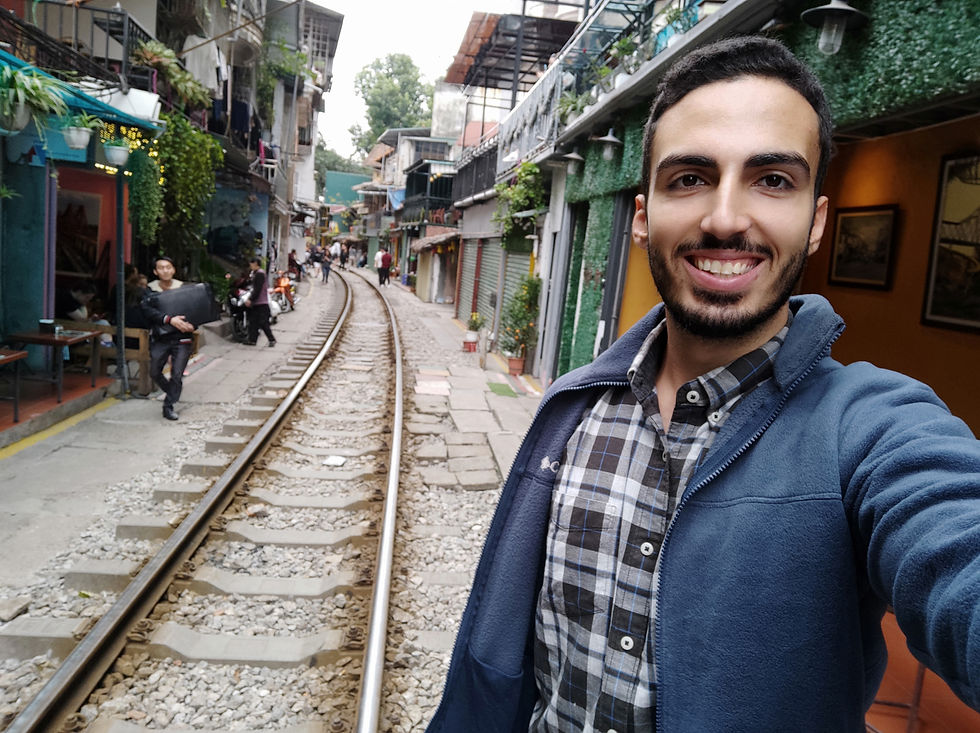
For dinner, we had chả cá - grilled fish hotpot, a local delicacy - with Sharon, an Argentine I had previously met in Hà Giang who was now finishing a 7-year trip around the world, followed by a few glasses of bia hơi - locally-brewed "fresh" light beer. This is the cheapest beer I've had in my life, with pints selling for as little as 5,000 dong ($0.2) at sidewalk bars with tiny plastic tables and chairs less than a foot off the ground. Being 1.88 meters tall, my knees were practically level with my mouth, not for the first time in Vietnam, but it was a fantastic people-watching method.
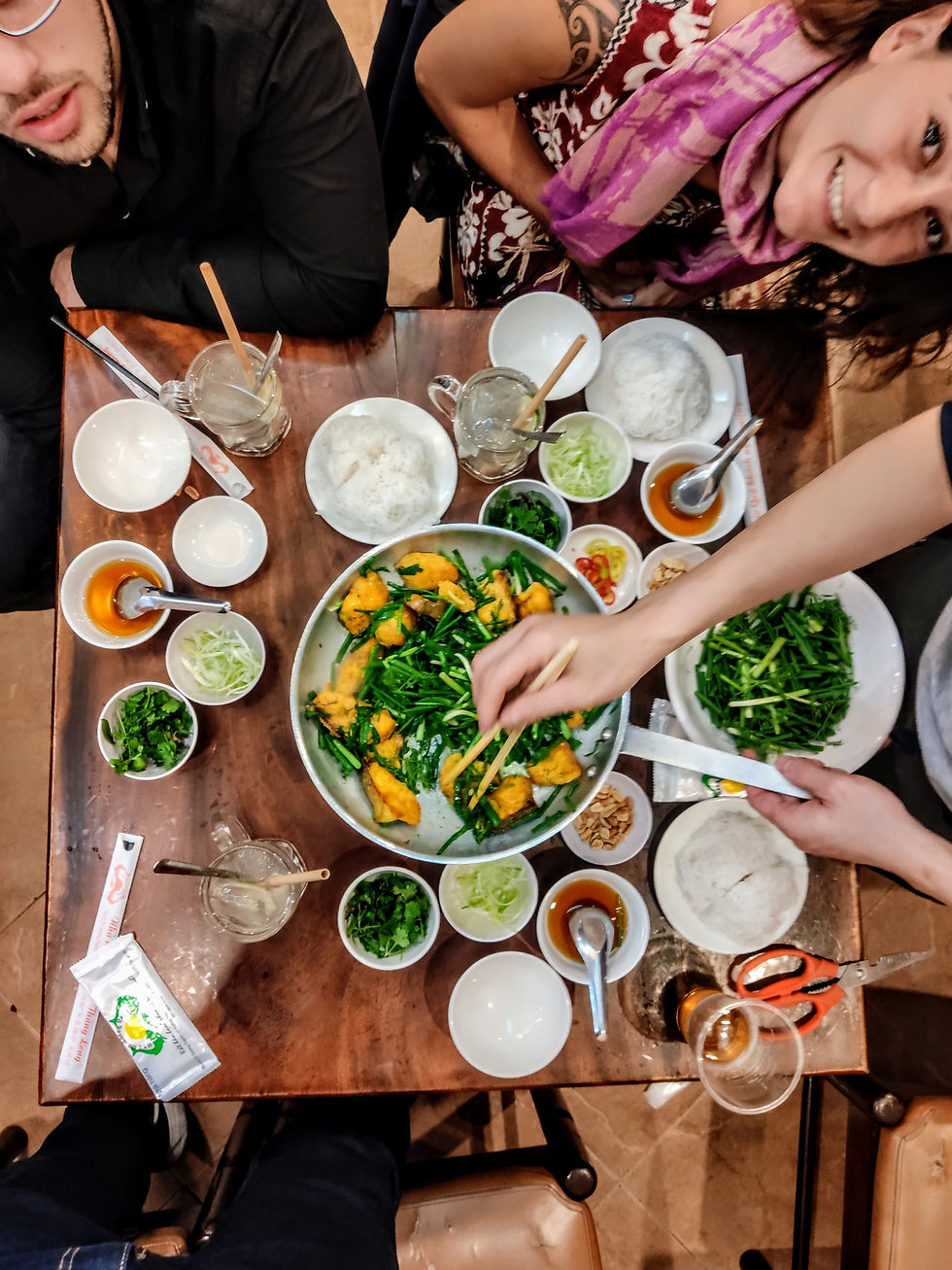
Sharon convinced us to join a walking tour of the downtown the next morning, where I finally saw a shop selling dog meat. Dog is a major food staple in northern Vietnam, but the influx of disgusted tourists has moved the shops selling the meat to more discreet locations. Interestingly, the meat prices fluctuate as dog meat is traditionally only consumed in the second half of the lunar month for good luck. I won't post a picture of the shop here since it's pretty graphic; the dead dogs look exactly like hairless live ones.
Despite being on my last day in the country, the tour provided me with a kind of closure, making a lot of things I had seen and experienced over the past month make a little bit more sense. The cell phone shops I had seen advertising specific numbers? Those were numbers containing lots of 6's and 8's, considered to bring good luck to their owners. Good numbers can sell for hundreds of dollars; bad-luck ones containing numbers like 49 are replaced by their owners. License plates are a similar story, with "unlucky" cars being sold for half-price, and lots of WiFi passwords in Vietnam are '88888888'.
The piles of trash I had seen burning by the side of the road up and down the country? Those were offerings made by Vietnamese people to their dead relatives, which included anything they might need in the afterlife, from clothes to inflatable servants. Most notably, fake banknotes minted by the "Bank of Hell" are also burnt so the dead will have disposable income, with Vietnamese dong, Chinese yuan, and US dollars widely available.
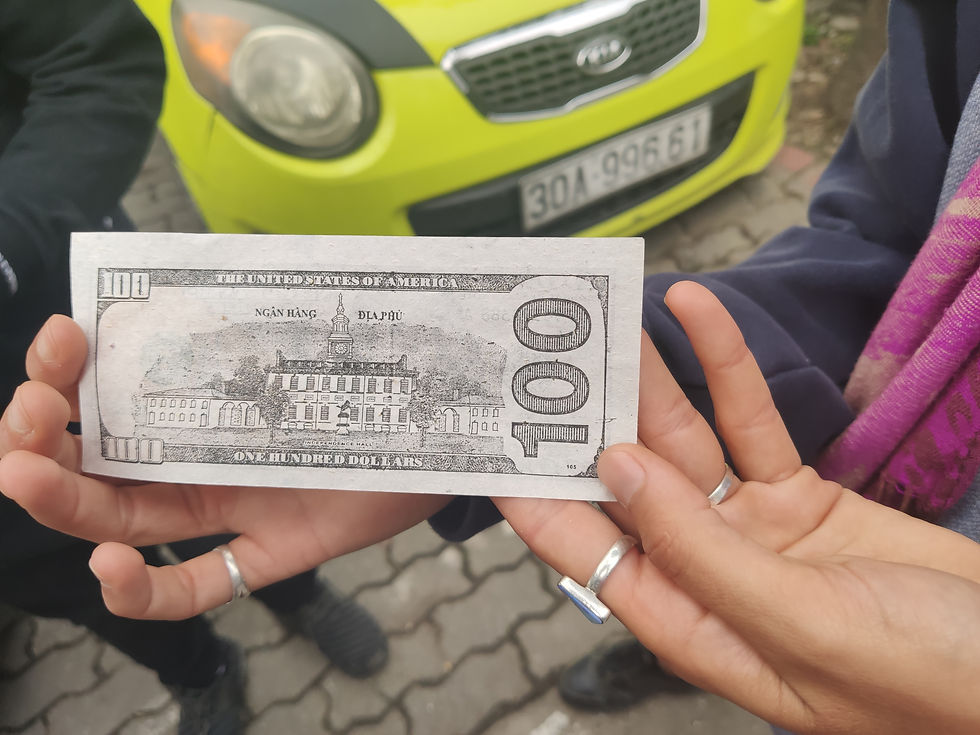
I've never been in a country that had so many cemeteries, which made sense after discovering the near-obsession the Vietnamese have with death and all the traditions surrounding it. Ceremonies for dead relatives, such as the ones I just mentioned, can last for over 100 years and will often be performed by family members who never even met the deceased. The most gruesome tradition I learned about was the eldest son's duty to dig up his parents' remains 3-5 years after their death to "change their clothes" and rebury the bones after cleaning them in front of the whole family. If any flesh remains it is cut away with a special knife which is then buried with the body.
After the tour, I went to return the motorcycle, the trip odometer reading 4588 kilometers, almost 1500 more than I had expected to ride on this trip. I had arrived in Hanoi with really low expectations, imagining a slightly cooler Saigon. The city had actually turned out to be rather nice, striking a good balance between chaotic and manageable, busy without being filthy, with plenty of interesting architecture in the Old Quarter and lots of good food. Most interesting to me were the touristy markets selling souvenirs and telling a very different story from the official Party narrative. Time does wonders to heal wounds, and only 55 years after the Communist victory, a blink of an eye in historical terms, Vietnamese flags are sold besides American and French ones on the streets of Hanoi. It was amazing, considering the scope of the trauma the war had inflicted, and more personally a source of hope for peaceful transformation in the Middle East despite the bad blood.
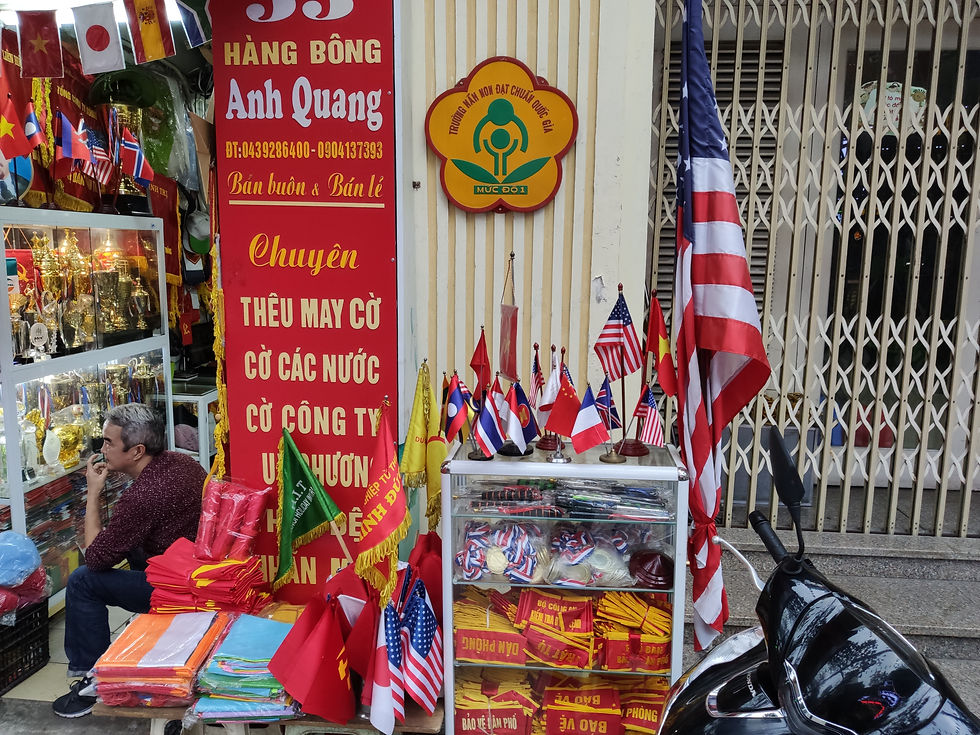
We prepared for our flight and had fantastic bún bò nam bộ (literally "southern-style noodles"), a great finale for the delicious month this trip had been. To balance it out, we had to wait nearly an hour for the bus to the airport which was clearly running on its own schedule, a rude welcome back to traveling on public transportation after a month of total independence. The airport had separate (empty) lines for Chinese passengers and prices that were shocking after so much time in Vietnam but were about to become the norm where I was headed next.

My trip to Vietnam was better than I had ever expected, combining diverse nature, great people, cultural discovery, and incredible motorcycle riding for an unforgettable month with nothing worse than some scratches and a mild burn to show for. Tạm biệt, Việt Nam, and on to the next destination!





Or maybe JFK copied it from the international Communist movement? *conspiracy theory music intensifies*
1) Pretty funny that the Vietnamese communist song quotes from JFK! (assuming the translation is correct...)
2) I think Dien Bien Phu is rightly counted among the most important battles of the twentieth century. A major defeat of a European colonial power by an insurgent movement, leading to withdrawal of that power and ultimately the complete unraveling of European empires.